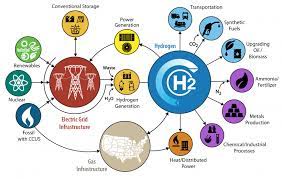.
.
From the Editorial Board, Pittsburgh Post Gazette, October 17, 2023
.
.
Green hydrogen is being touted around the world as a clean energy solution to take the carbon out of high-emitting sectors like transport and industrial manufacturing.
While it’s never good to miss out on a billion dollars in federal grants, it’s unlikely being passed over for “hydrogen hub” designation will seriously hurt southwestern Pennsylvania’s economy. That’s because cost-effective and environmentally friendly hydrogen fuel technology is still speculative — and even if it were to come to pass, a billion dollars will not come close to funding the required infrastructure.
The phrase “hydrogen hub” has been a staple of economic development conversations in Pittsburgh since the 2021 passage of the Infrastructure Investment and Jobs Act. Regional consortiums prepared bids for the federal Department of Energy, which is doling out $7 billion in funding to between six and ten regions to support infrastructure for the production and distribution of hydrogen fuel.
Last week, President Joe Biden announced two of the awards to the West Virginia-based Appalachian Regional Clean Hydrogen Hub (Arch2) and to the Philadelphia-based Mid-Atlantic Clean Hydrogen Hub (Mach2). The DOE passed over the Pittsburgh-based Decarbonization Network of Appalachia (DNA).
While the hub funding will certainly create some short-term construction jobs, including across the border into Pennsylvania, it is doubtful it will be transformative on its own. Further, the long-term economic and environmental viability of the relevant type of hydrogen fuel, called “blue,” is questionable, at best.
Hydrogen gas is odorless, colorless and highly combustible. When burned as fuel, it releases only water vapor. The trouble is in producing it.
“Blue” hydrogen is produced from breaking apart hydrocarbons — that is, fossil fuels — which is itself an energy-intensive process. The resulting carbon emissions are “captured and sequestered” either through underground storage or inputting them into other products.
“Gray” hydrogen involves no capture-and-sequestration and creates at least as many emissions as it reduces; “green” hydrogen is produced from breaking apart water molecules into hydrogen and oxygen using renewable energy, and is truly zero-carbon.
The Arch2 plan involves “blue” hydrogen meant to be used by Appalachia’s hard-to-decarbonize heavy industries, which are considered the best candidates for hydrogen fuel.
However, the price of capturing and sequestering carbon from southwestern Pennsylvania’s industrial sector, according to the Ohio Valley Institute and based on Allegheny Conference on Community Development estimates, would be $1 billion per year, and possibly twice that much. Further, generous emission-reduction estimates assume 95% capture-and-sequestration, which is not currently possible. And legacy infrastructure, like steel pipelines, don’t work for hydrogen: An entirely new network of (emission-heavy) plastic pipes would be needed.
A more realistic way to fund hydrogen infrastructure — though far more expensive to taxpayers — is the generous tax credits proposed in the Biden administration’s “Build Back Better” framework, amounting to at least 100% of the costs of carbon capture and sequestration. But the technology is too speculative to be worth the current proposed price tag of $1,000 for every person in the U.S.
Despite the hype, hydrogen is not a strong candidate as a transformative green fuel. Getting the funding couldn’t have hurt, but losing “hydrogen hub” status to West Virginia won’t cripple the region’s competitiveness.

